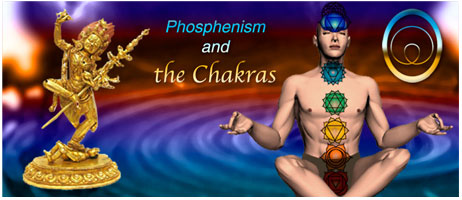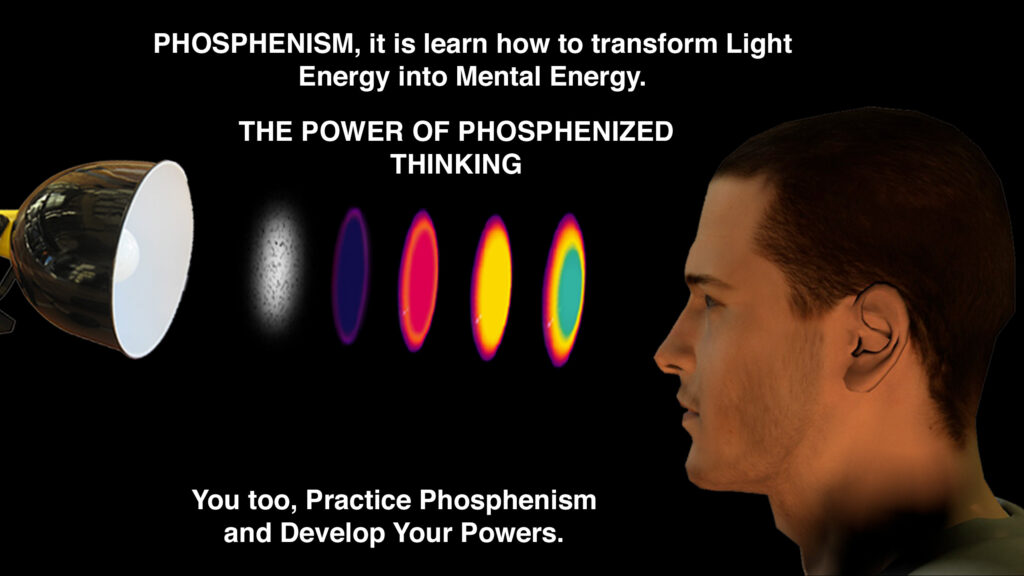CHAKRAS

The Hindu tradition defines the chakras as vortices of energy located on various points of the human body. The term chakra comes from a Sanskrit word meaning ‟wheel”. A similar principle can be found in other traditions: Chinese medicine, tantrism, Tibetan buddhism, the kabbalah or sufism, for example.
Phosphenism, a method of initiatory development designed by Doctor Francis LEFEBURE, a french physician and scientist, also recognizes the existence of the chakras and provides exercises for practicing with them. We will develop about this method later in this article.
There are seven main chakras. They are lined up vertically from the base of the spine to the top of the head. Each chakra is associated to a particular color and to certain physiological and psychological functions. The chakras can be considered as the organs of consciousness. They are represented by lotus flowers.
Vital energy (prâna, shakti, ki or chi) circulates throughout the body along channels called meridians. The chakras play a particular role in this network of energy. They function by rotation and garantee the spiritual, mental, physical and emotional health of the individual.
There is a parallel between the main chakras and the endocrinal glandular system. These glands could be the physical counterpart of the chakras.
The seven main chakras
Muladhara or root chakra is related to instincts, survival and basic human functions. This center is located in the perineum area, between the sexual organs and the anus. Though there is no endocrinal gland in this part of the body, certain authors consider that the root chakra is connected to the adrenalin glands, which are responsible of survival responses. Muladhara is represented by a lotus flower with four petals; its color is red.
Swadhisthana or chakra of the sacrum is located roughly three centimeters under the navel. It is related to emotions, sexuality and creativity. This chakra corresponds to the testicules and the ovaries, where the hormones that govern the cycle of reproduction are produced. Its symbol is a lotus with six petals; its color is orange.
Manipura is the chakra of the solar plexus. It is related to energy, as well as digestion and the assimilation of nutriments. It is supposed to correspond to the pancreas, a gland that plays a major role in the conversion of food into energy. Manipura is represented by a lotus flower with ten petal; its color is yellow.
Anahata or heart chakra is related to higher emotions, compassion, love, balance and well-being. It corresponds to the thymus, the organ of the immune and the endocrinal system that is responsable for combating diseases. Anahata is represented by a lotus flower with twelve petals; its color is green.
Vishuddha or throat chakra is related to growth. Its parallel is the thyroid gland which produces the growth hormone. Vishuddha is represented by a lotus flower with sixteen petals; its color is blue.
Ajna or third eye is the chakra of consciousness, time and light. It is related to the pineal gland which is sentive to light and produces melatonin, the hormone that regulates the sleep/wake cycle. Ajna is represented by a lotus flower with two petals; its color is indigo.
Sahasrara or crown chakra is the master chakra which controls all the others. It is the seat of spirituality. Its role is similar to the role of the pituitary gland which produces the hormones that control the endocrinal system. Sahasrara is represented by a lotus flower with a thousand petals; its color is purple.
Tantrism describes Kundalini as a coiled snake circling Mulhadara or root chakra three times. The exercises of the tantra are meant to awaken Kundalini, i.e. to let this energy rise from chakra to chakra. When Kundalini reaches Sahasrara or crown chakra, phenomena of illumination are produced.
The discoveries of Dr LEFEBURE on cerebral physiology, based on the systematic use of the phosphenes, bring a better understanding of these mecanisms and permit to reproduce them in a rather simple manner. The phosphenes are all the subjective sensations of light, i.e. those that are not directly provoked by light stimulating the retina.
Dr LEFEBURE discovered that the phenomena of illumination are produced by the synchronization of nervous cells in the brain. These synchronizations produce an electrical potential that diffuses itself into the zones of the brain that are responsible for sight, triggering perceptions of light. It is these perceptions of light that are called illumination.
Understanding these processes in a physiological way, Dr LEFEBURE invented the Gyrascope or Kundalini-triggering machine. Gyroscopic meditation permits a profound action on consciousness and the chakras in particular. Sustained practice can trigger the awakening of Kundalini with all the phenomena that correspond to the classical description of the surge of this force.
Gyroscopic meditation exercise
There is a virtual streaming Gyrascope available on our website. Do a phosphene and project it on the rotating blades of the Gyrascope for roughly three minutes.
Close your eyes, you will notice that the phoshene thus produced is rotational or whirling. (This is the proof of the existence of a mental whirling force, as the behavior of thoughts match the behavior of the phosphenes. Check Dr LEFEBURE’s book Kundalini Volume 1).
Concentrate on a chakra, the Ajna chakra or third eye, for example.
Visualize a dot of light, a star or a comet, for example, that is rotating on this chakra at a rhythm of one lap or half a lap per second. Use a precise beat from music or a metronome.
When the phosphene has disappeared, start the process again.
Pay attention to the sensations coming from this chakra.
Practice this exercise during 15 to 45 minutes.
To produce phenomena of illumination, practice this exercise every day. After two weeks, you will most probably obtain very advanced phenomena. By sustaining this practice, you can produce the awakening of Kundalini.
Importante Note
We have done our best to provide you with the most accurate translation of our french website. Nevertheless, it is possible that some language errors may remain. So, don’t hesitate to contact us to communicate them to us.
Thank you for your indulgence and for your consideration of the many hours spent translating all our pages and, more particularly, all the testimonies we share with you so that you may become aware of the impact that Phosphenism can have on those who practice it.
Wishing you the best with your practice of Phosphenism.
Daniel Stiennon (Dr. LEFEBURE School Director, France)


